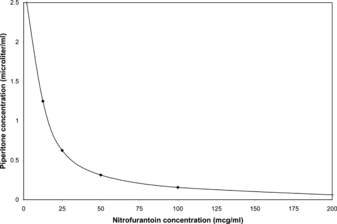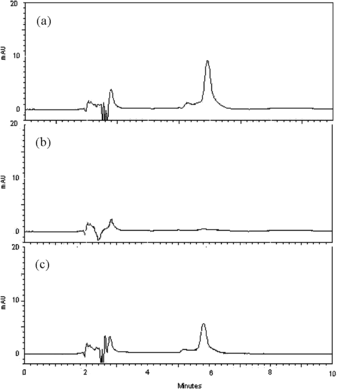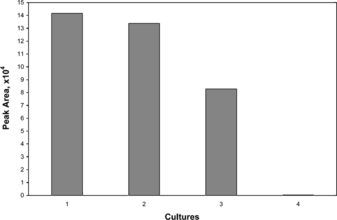Abstract
Monoterpenes, including piperitone, increase nitrofurantoin susceptibility in members of the family Enterobacteriaceae. To understand interactions of these compounds, a nitrofurantoin-resistant clinical strain of Enterobacter cloacae. was subjected to two-dimensional checkerboard dilutions of piperitone and nitrofurantoin. Synergy was demonstrated with all combinations of these compounds. HPLC analysis showed that E. cloacae. metabolized nitrofurantoin to compounds that were not detectable by chromatography with UV detection and lacked bactericidal activity. E. cloacae. produced a cell-associated nitroreductase, whose activity was reduced by piperitone in a dose-dependent manner. More than one mechanism may be involved in the synergistic interaction of these compounds.
Introduction
Nitrofurantoin, 1-{[(5-nitro-2-furanyl)methylene]amino}-2,4-imidazolidinedione, is used for the treatment of urinary tract infections (Schlager et al., Citation1998; Cahen & Honderlick, Citation2000; Rogers et al., Citation2004). As with other nitro drugs, the bactericidal activity of nitrofurantoin requires nitroreduction. It is first reduced by bacterial nitroreductases to antibacterial short-lived intermediates, which are then further metabolized to compounds without antibacterial activity (McOsker & Fitzpatrick, Citation1994; Sisson et al., Citation2002).
We previously have shown that different plant monoterpenes, including piperitone, increase the antibacterial activities of nitrofurantoin and furanidazole for the members of the family Enterobacteriaceae (Shahverdi et al., Citation2004aCitation2004b). The reason for this enhancement is unknown. In this study, we have determined the mode of interaction of piperitone and nitrofurantoin against Enterobacter cloacae.. We also have evaluated the effects of piperitone on the metabolism of nitrofurantoin and on nitroreductase production in this bacterium.
Materials and Methods
Bacterial cultures
Enterobacter cloacae. resistant to high nitrofurantoin concentration and Escherichia coli. that was sensitive to nitrofurantoin were grown in Mueller-Hinton medium and used for this study. These strains were clinical isolates and reserved as numbers PHTCC 2604 and PHTCC 26011 at in the Department of Food and Drug Control Type Culture Collection, Faculty of Pharmacy, Tehran Medical Sciences University, Tehran, Iran.
Checkerboard test
The checkerboard method (White et al., Citation1996) was used to examine the effects of combinations of piperitone and nitrofurantoin against a nitrofurantoin-resistant clinical strain of Enterobacter cloacae. PHTCC 2604. dl.-Piperitone [3-methyl-6-(1-methylethyl)-2-cyclohexen-1-one] was kindly provided by Charabot (Grasse, France). Twofold serial dilutions of 12.5–200 µg/mL of nitrofurantoin and 0.5–2.5 µL/mL of piperitone (in 0.5 µL/mL dilution increments) were used for this test. Bacteria from logarithmic cultures (105) grown in Mueller-Hinton broth were distributed into test tubes containing various concentrations of the different compounds in the same medium.
After incubation for 24 h growth of the cells, fractional inhibitory concentration (FIC) indices were calculated as FICnitrofurantoin + FICpiperitone, where FICnitrofurantoin and FICpiperitone represent the minimum concentrations of nitrofurantoin and piperitone, respectively, that inhibited bacterial growth; FICnitrofurantoin = MICnitrofurantoin combination/MICnitrofurantoin alone; and FICpiperitone = MICpiperitone combination/MICpiperitone alone. A mean FIC index was calculated based on the equation FICindex = FICnitrofurantoin + FICpiperitone and the interpretation was made as follows: synergistic (< 0.5), additive (0.5–1.0), indifferent (> 1), or antagonistic (> 4.0) (White et al., Citation1996).
Metabolism of nitrofurantoin by E. cloacae. in the presence and absence of piperitone
The nitrofurantoin-resistant E. cloacae. was grown in Mueller-Hinton broth supplemented with a noninhibitory concentration of nitrofurantoin (7.5 µg/mL) in the presence and absence of a subinhibitory concentration of piperitone (1 µL/mL) at 37°C. For a control, Mueller-Hinton medium containing nitrofurantoin with no bacteria was used. High-performance liquid chromatographic (HPLC) analysis after incubation with E. cloacae. in the presence or absence of piperitone was used to investigate the effect of piperitone on the metabolism of nitrofurantoin by E. cloacae.. Samples were removed at 0 and 18 h and extracted with ethyl acetate (Muth et al., Citation1996) and analyzed by HPLC using a 5 µm C-18 reversedphase column (Nucleosil 100–5, 250 × 4 mm) from Knauer (Berlin, Germany). The chromatographic apparatus consisted of a Wellchrom model K-1001 pump and a model K 2501 UV detector from (Knauer). The mobile phase was a mixture of 0.1 M sodium perchlorate–acetonitrile–glacial acetic acid (72:27.5:0.5 v/v/v) at a flow rate of 1 mL/min (Galeano Diaz et al., Citation1997). The concentration of nitrofurantoin before and after incubation was monitored at 376 nm. The growth of cells was monitored using plate counting.
Effect of E. cloacae. on the bactericidal activity of nitrofurantoin
A nitrofurantoin resistant-strain of E. cloacae. was grown with a noninhibitory concentration of nitrofurantoin (7.5 µg/mL) for this experiment. After 18 h incubation of the cultures in the presence or absence of subinhibitory concentration of piperitone and centrifugation, the supernatants were filter-sterilized. The residual antibacterial activity of nitrofurantoin was determined against a sensitive strain of E. coli., using a conventional cylinder plate assay (Mendez et al., Citation2005). As controls, media containing nitrofurantoin with and without piperitone were also tested.
Assay of nitroreductase activity
Nitroreductase activity in cultures of E. cloacae. was determined by measuring the conversion of 4-nitrobenzoic acid to 4-aminobenzoic acid (McOsker & Fitzpatrick,1994; Sisson et al., Citation2002). Thirty µg/mL of 4-nitrobenzoic acid from Fluka (Fluka Chemie AG, Buches, Switzerland) was added to the cultures, which were inoculated at 37°C overnight. For measuring the effect of piperitone on production of nitroreductase, 0.5 or 1 µL/mL of piperitone was added to some of the cultures before incubation. The cultures were centrifuged at 12,000 rpm for 10 min to pellet the cells. The amount of 4-aminobenzoic acid produced was detected in supernatants by diazotization of the amine in the presence of sodium nitrite under acidic conditions at 4°C and addition of NEDD [N.-(1-naphthyl)ethylenediamine dihydrochloride] (Rafii et al., Citation1991). The dye produced was measured at 540 nm with a Cecil model 9200 spectrophotometer (Cambridge, UK). The cell density was measured at 600 nm. Each assay was performed at least three times. The amount of nitroreductase produced in each culture was measured as previously described (Rafii et al., Citation2003). In separate experiments, the presence of nitroreductase in extracellular fractions of the cells was examined. Overnight cultures of E. cloacae. were centrifuged at 12,000 rpm and the supernatants were filtered through an 0.2-µm filter. 4-Nitrobenzoic acid was added to the sterilized supernatants with or without 0.5–1 µL/mL of piperitone and incubated overnight at 37°C. The samples were assayed for the presence of 4-aminobenzoic acid as described previously (Rafii et al., Citation1991).
Results and Discussion
Nitrofurantoin, combined with piperitone, caused a significant decrease in the MICs of both of the drugs for E. cloacae. compared with the MIC for each compound alone (). The MICs of nitrofurantoin and piperitone singly were 275 µg/mL and > 2.5 µL/mL, respectively, whereas in combination they decreased to 25 µg/mL and 0.625 µL/mL, respectively, which is a 10-fold reduction of the MIC of nitrofurantoin and a four-fold reduction of piperitone for this strain. The FIC index for E. cloacae. was 0.318, which shows the synergistic action of piperitone with nitrofurantoin (White et al., Citation1996).
Figure 1 Isobologram showing the synergistic effect of combination of piperitone with nitrofurantoin on the inhibition of Enterobacter cloacae..

Piperitone also affected the metabolism of nitrofurantoin by E. cloacae.. The use of a noninhibitory concentration of nitrofurantoin in the presence and absence of a subinhibitory concentration of piperitone allowed the growth of bacteria. HPLC analysis showed that E. cloacae. completely metabolized nitrofurantoin during 18 h incubation (). However, the metabolism of nitrofurantoin was partially inhibited in the presence of 1 µL/mL piperitone. In the control medium without bacteria, the nitrofurantoin peak was present in an HPLC profile of a sample extracted after 18 h incubation (a). This peak was not present in the HPLC profile of a sample extracted after incubation with E. cloacae. in the absence of piperitone, indicating the complete metabolism of nitrofurantoin by E. cloacae. (b). A smaller peak of nitrofurantoin was still present in the HPLC profile of nitrofurantoin incubated with E. cloacae. in the presence of piperitone (c), demonstrating that piperitone diminished the ability of E. cloacae. to metabolize nitrofurantoin.
Figure 2 HPLC chromatograms of nitrofurantoin extracts from the samples after 18 h of incubation with noninoculated medium (a), E. cloacae. (b), or E. cloacae. containing 1 µL/mL of piperitone (c). The peak eluted at 5.8 min represents nitrofurantoin.

compares the amount of nitrofurantoin remaining (area under HPLC peak) in the medium after 18 h of incubation in the presence and absence of E. cloacae. and piperitone. One reason for the reduced metabolism of nitrofurantoin in the presence of piperitone could be diminished growth of E. cloacae.. shows a 10-fold reduction in the growth of E. cloacae. grown with 7.5 µg/mL of nitrofurantoin in the presence of 1 µL/mL of piperitone, compared with growth of this bacterium in the absence of piperitone. Because E. cloacae. is resistant to up to 275 µg/mL of nitrofurantion, the low concentration of nitrofurantoin by itself did not inhibit the growth. However, piperitone enhanced the bactericidal activity of nitrofurantoin, which resulted in reduction of growth of this bacterium with nitrofurantoin.
Figure 3 Nitrofurantoin remaining in Mueller-Hinton medium before incubation (bar 1), after 18 h of sterile incubation (bar 2) with E. cloacae. and 1 µl piperitone (bar 3), and with E. cloacae. only (bar 4). The areas of the peaks found by HPLC were measured by integration.

Table 1.. Growth of nitrofurantoin-resistant E. cloacae. in media containing a noninhibitory concentration of nitrofurantoin in the presence and absence of a subinhibitory concentration of piperitone.
The bactericidal activity of nitrofurantoin after incubation with E. cloacae. was also diminished. This was shown by measuring its effect on the growth of sensitive E. coli. strain in a cylinder-plate assay. shows the diameter of the zone of inhibition of growth of the sensitive E. coli. strain by nitrofurantoin before and after it was incubated with E. cloacae.. The filter-sterilized supernatant of E. cloacae. incubated with nitrofurantoin did not inhibit the growth of E. coli.. When a subinhibitory concentration of piperitone was also present in the culture, the supernatant was inhibitory. Piperitone decreased the metabolism of nitrofurantoin to noninhibitory substances in addition to enhancing its effect.
Table 2.. Antibacterial activity of nitrofurantoin before and after incubation with Enterobacter cloacae. in the presence and absence of piperitone against a nitrofurantoin-sensitive strain of Escherichia coli..
Piperitone also reduced nitroreductase activity of E. cloacae. in a dose-dependent manner, as was evident from the reduction of 4-nitrobenzoic acid to 4-aminobenzoic acid (). Addition of 0.5 µL/mL and 1 µL/mL of piperitone to the cells before overnight incubation resulted in decreases in nitroreductase activity by 33% and 56%, respectively. The nitroreductase activity was cell-associated and the supernatant had negligible activity in either of the cultures. It appears that the nitrofurantoin had to enter the cells before it could be reduced to the toxic intermediate via nitroreductase and further be metabolized to nontoxic compounds.
Table 3.. Nitroreductase produced by nitrofurantoin-resistant E. cloacae. in the presence and absence of piperitone, units per Optimal Density unit of cells (A.600).
We conclude that resistance of E. cloacae. to nitrofurantoin is the result of conversion of this compound to metabolites without antimicrobial activity. This resistance is compromised in the presence of piperitone, which enhances the bactericidal activity in a synergistic manner. Although piperitone decreases the cell-associated nitroreductase activity, it could also be involved in the enhancement of permeability of the membrane to nitrofurantoin (Trombetta et al., Citation2005).
Acknowledgments
This study was supported by a grant from the Deputy of Research, Medical Sciences/University of Tehran. We acknowledge H. Tofigi for his excellent technical assistance in this project.
References
- Cahen P, Honderlick P (2000): Nitrofurans: A modern treatment for uncomplicated urinary infections? Pathol Biol 48: 470–471.
- Galeano Diaz T, Guiberteau Cabanillas A, Acedo Valenzuela MI, Correa CA, Salinas F (1997): Determination of nitrofurantoin, furazolidone and furaltadone in milk by high-performance liquid chromatography with electrochemical detection. J Chromatogr A 764: 243–248.
- McOsker C, Fitzpatrick PM (1994): Nitrofurantoin: Mechanism of action and implications for resistance development in common uropathogens. J Antimicrob Chemother 33(Suppl. A): 23–30.
- Mendez AS, Weisheimer V, Oppe TP, Steppe M, Schapoval EE (2005): Microbiological assay for the determination of meropenem in pharmaceutical dosage form. J Pharm Biomed Anal 33: 649–653.
- Muth P, Metz R, Siems B, Bolten WW, Vergin H (1996): Sensitive determination of nitrofurantoin in human plasma and urine by high-performance liquid chromatography. J Chromatogr A 729: 251–258.
- Rafii F, Franklin W, Heflich RH, Cerniglia CE (1991): Reduction of nitroaromatic compounds by anaerobic bacteria isolated from the human gastrointestinal tract. Appl Environ Microbiol 57: 962–968.
- Rafii F, Wynne R, Heinze TM, Paine DD (2003): Mechanism of metronidazole-resistance by isolates of nitroreductase-producing Enterococcus gallinarum. and Enterococcus casseliflavus. from the human intestinal tract. FEMS Microbiol Lett 225: 195–200.
- Rogers RG, Kammerer-Doak D, Olsen A, Thompson PK, Walters MD, Lukacz ES, Qualls C (2004): A randomized, double-blind, placebo-controlled comparison of the effect of nitrofurantoin monohydrate macrocrystals on the development of urinary tract infections after surgery for pelvic organ prolapse and/or stress urinary incontinence with suprapubic catheterization. Am J Obstet Gynecol 191: 182–187.
- Schlager TA, Anderson S, Trudell J, Hendley JO (1998): Nitrofurantoin prophylaxis for bacteriuria and urinary tract infection in children with neurogenic bladder on intermittent catheterization. J Pediatr 132: 704–708.
- Shahverdi AR, Rafii F, Tavassoli F, Bagheri M, Attar F, Ghahraman A (2004a): Piperitone from Mentha longifolia. var. chorodictya. Rech f. reduces the nitrofurantoin resistance of strains of Enterobacteriaceae. Phytother Res 18: 911–914.
- Shahverdi AR, Rafii F, Fazeli MR, Jamalifar H (2004b): Enhancement of antimicrobial activity of furazolidone and nitrofurantoin against clinical isolates of Enterobacteriaceae by piperitone. J Aromather 14: 77–80.
- Sisson G, Goodwin A, Raudonikiene A, Hughes NJ, Asish Mukhopadhyay K, Berg DE, Hoffman PS (2002): Enzymes associated with reductive activation and action of nitazoxanide, nitrofurans, and metronidazole in Helicobacter pylori.. Antimicrob Agents Chemother 46: 2116–2123.
- Trombetta D, Castelli F, Sarpietro MG, Venuti V, Cristani M, Daniele C, Saija A, Mazzanti G, Bisignano G (2005): Mechanisms of antibacterial action of three monoterpenes. Antimicrob Agents Chemother 49: 2474–2478.
- White RL, Burgess DS, Manduru M, Bosso JA (1996): Comparison of three different in vitro methods of detecting synergy: time-kill, checkerboard, and E test. Antimicrob Agents Chemother 40: 1914–1918.
